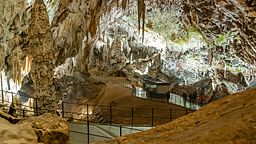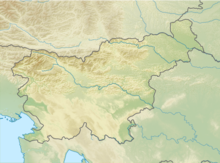Postojna Cave System
| Postojna Cave | |
|---|---|

Passage in Postojna Cave
|
|
| Location | Postojna, Slovenia |
| Coordinates | 45°46′52.5″N 14°12′20.5″E / 45.781250°N 14.205694°ECoordinates: 45°46′52.5″N 14°12′20.5″E / 45.781250°N 14.205694°E |
| Depth | 115 m (377 ft) |
| Length | 24,120 m (79,130 ft) |
| Geology | limestone |
| Access | by foot |
| Registry | Cave E-Cadastre |
|
|
Postojna Cave (Slovene: Postojnska jama; German: Adelsberger Grotte; Italian: Grotte di Postumia) is a 24,340 m long karst cave system near Postojna, southwestern Slovenia. It is the second-longest cave system in the country (following the Migovec System) as well as one of its top tourism sites. The caves were created by the Pivka River.
The cave was first described in the 17th century by the pioneer of study of karst phenomena, Johann Weikhard von Valvasor, although graffiti inside dated to 1213 indicates a much longer history of use. In 1818, when the cave was being prepared for a visit by Francis I, the first Emperor of the Austria-Hungary, a new area of the cave was discovered accidentally by local Luka Čeč.
In 1819, Archduke Ferdinand visited the caves, this is when the caves became officially known as a tourist destination. Čeč became the first official tourist guide for the caves when the caves were opened to the public. Electric lighting was added in 1884, preceding even Ljubljana, the capital of Carniola, of which the cave was part at the time, and further enhancing the cave system's popularity.
In 1872, cave rails were laid along with first cave train for tourists. At first, these were pushed along by the guides themselves, later at the beginning of the 20th century a gas locomotive was introduced.
During World War I, Russian prisoners of war were forced to construct a bridge across a large chasm inside the cave.
During World War II, German occupying forces used the cave to store nearly 1,000 barrels of aircraft fuel, which were destroyed in April 1944 by Slovene Partisans. The fire burned for seven days, destroying a large section of the cave and blackening the entrance.
...
Wikipedia

